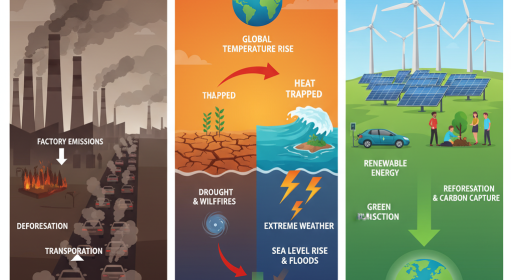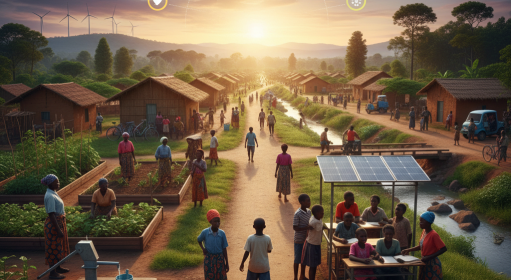Floods in Nigeria: Environment and Climate Change Link
Floods follow the rainy season between April and October. But instead of being seasonal inconveniences, they now destroy lives and livelihoods.
- In 2022, Nigeria saw its worst floods in a decade: 612 people killed, 1.4 million displaced, and over 332,000 hectares of farmland lost.
- In May 2025, Mokwa in Niger State, a town with no history of flooding, was overwhelmed after a sudden torrential downpour. At least 151 people died and more than 3,000 houses were submerged.
Why this keeps happening:
Poor urban drainage, settlement of floodplains, and mismanaged dams combine with unpredictable rainfall. Cameroons Lagdo Dam release worsened the 2022 floods, while Nigerias own Dasin Hausa Dam intended to prevent such disasters remains unfinished. Climate change means towns like Mokwa once considered low risk can face catastrophic floods overnight.
Oil Spills and Climate Change Impact on Communities
While floods strike quickly, oil spills quietly destroy ecosystems over decades.
- Between 1976 and 2001, over 6,800 spills released nearly 3 million barrels of oil in the Niger Delta.
- Mangroves, rivers, and groundwater remain heavily contaminated, making the region one of the most polluted places in the world.
- A 2023 study revealed that weak enforcement and overlapping agencies have left many spill sites uncleaned.
The result is poisoned farmland, collapsed fisheries, and worsening poverty. Communities are trapped in a cycle of pollution while companies face little accountability. Until enforcement and cleanup improve, the Niger Delta will remain a disaster zone.
Disaster Risk Reduction and Environmental Management in Nigeria
Nigeria is getting better at predicting risks.
- The Nigeria Hydrological Services Agency issues annual flood forecasts. In 2025, they flagged 30 states and more than 1,200 communities as high risk.
- Satellite systems like Copernicus Sentinel now provide real time monitoring of rising waters.
But forecasts often do not save lives. Many communities lack evacuation routes, shelters, or resources to move. The poorest and most vulnerable including women, children, the elderly, and the disabled are hit the hardest. Warnings often never reach them, or they are physically unable to evacuate in time.
“Risk assessments are valuable, but they must be translated into action on the ground.“
Equity, Vulnerability, and Climate Change in Nigeria
Disaster risks are not shared equally across Nigeria. Some groups and communities are far more exposed when floods or oil spills strike.
Geography and poverty play a big role. The urban poor often live in informal settlements or slums on low lying land. Rural families farming along floodplains also have few relocation options. Their homes are fragile, savings are scarce, and when floods hit, recovery is slow. Women and children in these communities often face the greatest hardship and displacement.
Information gaps add to the danger. Remote villages may not receive early warnings or evacuation notices. Illiteracy and language barriers sometimes prevent people from understanding alerts, so communities are caught off guard even when floods were predicted.
Mobility challenges make matters worse for the elderly and disabled. During the 2022 floods, many could not evacuate quickly or lacked transport to reach shelters. In crowded camps, women, children, and vulnerable groups have also faced neglect, exploitation, and gender-based violence.
Recognizing these inequities is now central to disaster planning. Agencies and NGOs increasingly use gender and age specific data to identify who needs the most protection. Schools, hospitals, and community centers are being prioritized alongside roads and bridges. Early warning systems are more effective when delivered in local languages and through trusted community leaders.
By addressing these gaps outreach, mobility support, and stronger social safety nets Nigeria can significantly reduce the human toll of disasters. A disaster plan that ignores vulnerable groups leaves a dangerous blind spot. A strong risk strategy ensures that no one is left behind.
Breaking the Cycle
Floods and oil spills keep repeating in Nigeria not because they are unavoidable, but because lessons are forgotten and warnings ignored. Forecasts are not acted upon, regulations remain weak, and infrastructure projects are left incomplete.
Yet the tools exist:
- Modern forecasting: Advanced weather models and local alerts can give communities time to prepare.
- Climate modeling: Predictive models help plan long-term flood defenses and spill response.
- Local knowledge and early warnings: Community chiefs and NGOs play a key role in communicating dangers quickly.
These can prevent disasters if backed by political will and proper investment.
Every year brings another tragic headline. But with stronger planning, the story can change from disaster strikes again to disaster averted. The path forward lies in using risk assessments not as reports to shelve, but as roadmaps to resilience. Preparedness is not only for governments. Communities can demand action, plan local responses, and spread awareness. Disasters repeat when warnings are ignored, but resilience grows when everyone is involved.




